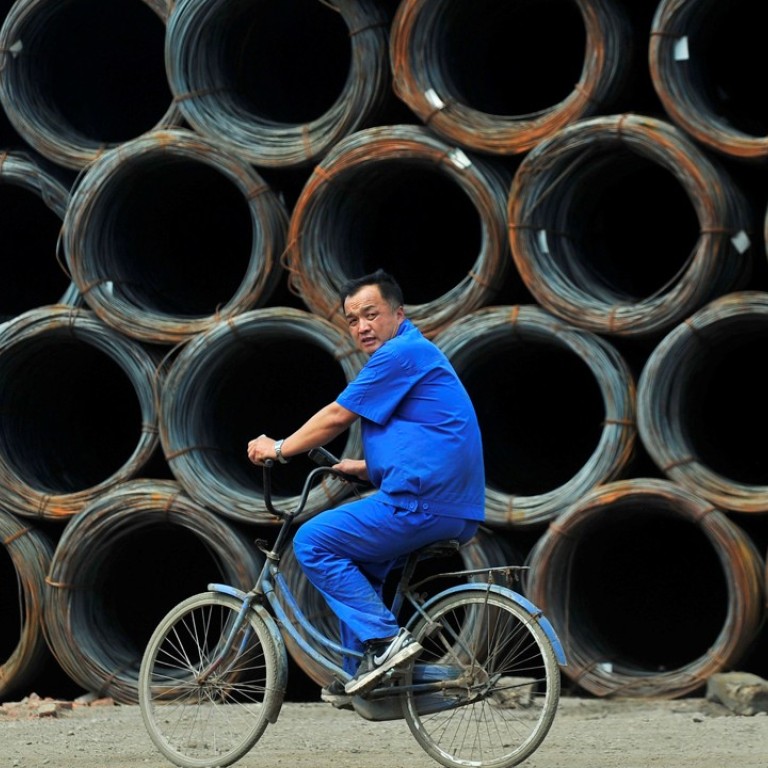
China’s economic growth slows in October after Xi Jinping omits target from congress speech
Retail sales slow despite weeklong holiday, while fixed-asset investment, industrial output also decelerate
From home construction to industrial output, China’s economic momentum broadly cooled last month as the country continues to shift focus from national growth targets towards more sustainable development.
The figures come about a month after Chinese President Xi Jinping notably stopped short of putting a number on long-term growth in his epic speech to the Communist Party’s national congress, opting instead to focus on the environment and “growth quality”.
Nonetheless, after reporting 6.9 per cent growth for the first six months, China remains on course to report its first full-year acceleration in growth since 2010, despite the government’s determination to rein in the credit juggernaut and debt piles that have been blamed for financial fragility and damaging growth prospects.
But concerns about how the world’s second-biggest economy can rebalance itself remain. A research report by the European Central Bank published earlier this month argued that a “swift rebalancing” of China’s economy, with aggressive structural changes, would knock three percentage points off its growth over three years and slow expansion in the euro zone by 0.3 percentage points.
“China intends to strike a balance between growth, debt and leveraging,” Zhou Hao, chief emerging market economist at Commerzbank, wrote in a note.
According to figures released on Tuesday by the National Bureau of Statistics, China’s fixed-asset investment rose 7.3 per cent in the first 10 months, slowing from 7.5 per cent growth in the year through September. Meanwhile, despite the weeklong national holiday in the month, retail sales growth in October slowed to 6.2 per cent from 6.5 per cent in September.
Industrial output expansion also eased to 6.2 per cent in October from 6.6 per cent a month earlier, the bureau said.
The data came a day after the People’s Bank of China released a slew of credit figures showing bank loans and aggregate financing almost halved in October from September.
New yuan loans totalled 663 billion yuan (US$99.62 billion) in October from 1.27 trillion in September, while aggregate financing, a broad measure of credit, dropped to 1.04 trillion yuan from 1.82 trillion yuan, the central bank said on Monday.
While Beijing would not neglect economic expansion completely during Xi’s second five-year term, under his economic policies of “deleveraging” and “supply-side structural reforms” it was likely to tolerate lower growth and put an end to freewheeling credit and debt, analysts said.
Louis Kuijs, chief Asia economist at Oxford Economics, said a faster decline in housing sales and construction – an immediate result of Beijing’s efforts to contain a housing price bubble – might weigh on future growth.
The country’s red-hot property market, which has been a major growth driver in previous years but which is also viewed as a major source of financial risk, is cooling. Home sales in October fell 8.6 per cent year on year, while housing construction starts dropped 2.9 per cent.
“Policymakers remain focused on reducing financial risk and deleveraging part of the financial system while aiming for a gradual easing of credit growth,” Kuijs wrote in a note.
Meanwhile, the broad-based softening of China’s growth momentum last month could be a result of seasonal factors and short-term disruptions.
Liu Xuezhi, a macro analyst at Bank of Communications in Shanghai, said industrial output in October was greatly affected by the heightened environmental protection efforts ahead of and during last month’s party congress, especially in the provinces surrounding Beijing.
The government’s pro-growth efforts had ebbed as “actual economic growth stands firmly above the full-year target and the government hopes to press ahead with capacity reduction” and financial deleveraging, he said.
China’s relatively strong performance in 2017 is an important contributor to global economic recovery, and as a result, fears about a possible economic hard landing have largely waned.
For its part, Beijing remains typically upbeat about the latest figures.
“The economy continues to operate in a reasonable range in terms of production, employment, inflation and corporate profitability,” statistics bureau spokeswoman Liu Aihua said in Beijing.
“The growth momentum remains good, laying a solid foundation to achieve the full-year targets.”

